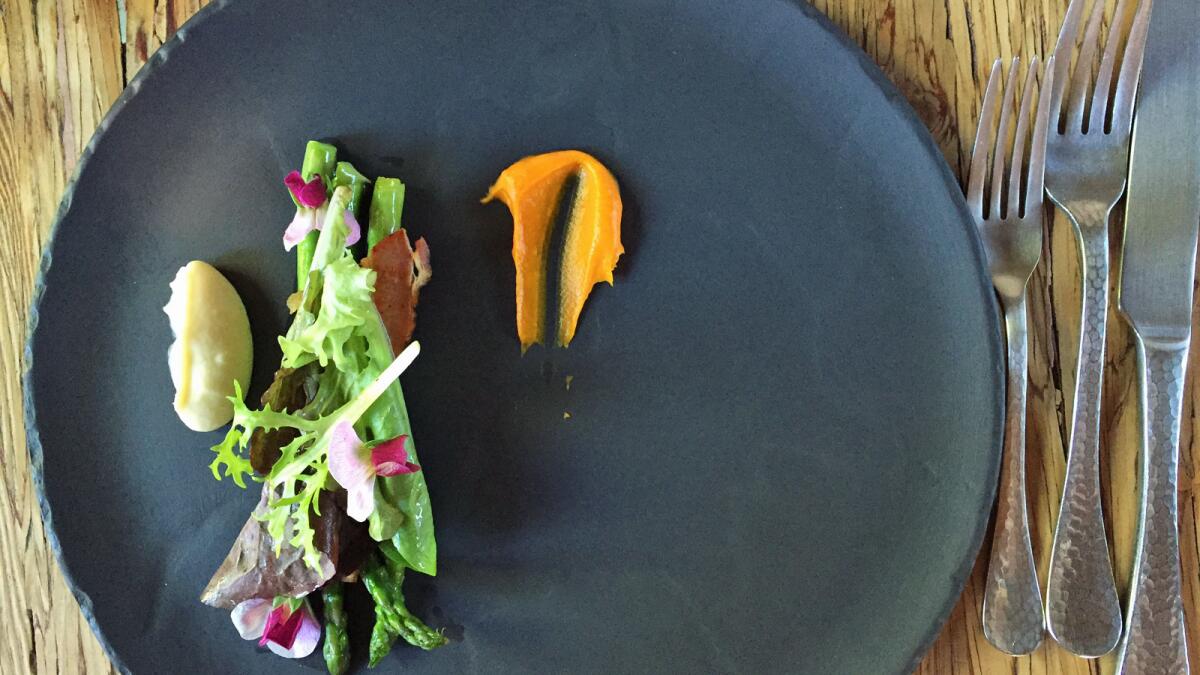What we’re into: Brunch at Pizzeria Mozza, chicken and rice, and Corazon de Tierra in Baja
- Share via
Mozza’s brunch: Do Italians eat brunch? Not really. Their dedication to a simple breakfast of coffee and toast or pastry could probably be sanctified as a state religion. Nancy Silverton abandoned the breakfast business when she started the various Mozzas, devoting herself instead to the demands of pizza and mozzarella. But as of a couple of weeks ago, there is now weekend brunch at Pizzeria Mozza: decent cappuccino and things like oniony bacon pizzas topped with a fried egg; luscious brisket hash, cooked overnight in the embers of the wood oven and topped with a fried egg; soft roasted eggplant with spicy tomatoes — uovo in purgatorio, like a Neapolitan version of shakshuka — topped with a fried egg; a breakfast sandwich topped with a fried egg; and a cheese-dusted endive salad topped with a fried egg. It’s a cheerful way to begin a Sunday afternoon. (The standard disclosure applies: Silverton is a family friend.) — Jonathan Gold

Chicken and rice: There’s something about the combination of chicken and rice, two utilitarian ingredients, that can, under the right circumstances of technique and sourcing, make for delicious alchemy. Witness Hainan Chicken. Also Nong’s Khao Man Gai, the tiny Thai restaurant and tinier food cart in Portland, Ore., that serves some of the best chicken and rice on the West Coast. Then there’s the Three Cup Jidori Chicken at Pine & Crane in Silver Lake, a pretty great chicken dish that’s made even more so by the particular rice the restaurant serves with it. This rice is from Morihiro Onodera, formerly the sushi chef and owner of Mori Sushi, who sold his restaurant to become a potter — and a rice farm owner. Onodera’s rice is the Japanese short-grain koshihikari variety, grown on a farm in Uruguay — Onodera says that the conditions in Uruguay are similar to those in his native Japan. Cooked in perfectly articulated grains, this rice is doubtless pretty good with raw fish, and it’s terrific with a bowl of chicken. — Amy Scattergood

An asparagus salad with bacon, squash puree and cauliflower puree.
Will travel for food: Just arriving at Corazón de Tierra, a restaurant off highway 3 in Baja California’s Guadalupe Valley, is a reward. You will need to brave a series of winding, seemingly endless unpaved roads full of ridiculous potholes, but it’s well worth it. This is a farm-to-table Mexican restaurant, in every sense of the overused term. Diego Hernandez takes the produce grown on the restaurant’s property and turns it into spectacular multi-course meals. Recent dishes included shards of pale pink beet meringue topped with a dollop of goat cheese and a sweet beet puree; and rounds of fried dough with smoked tuna, avocado puree and onion ash. The presentation is what you’d expect from any of the top fine dining restaurants in the states, but at a quarter of the price. It’s 880 pesos per person. Depending on the exchange rate, that’s around $46. If you can’t make it south of the border, Hernandez says he plans to open a restaurant in Los Angeles in the near future. — Jenn Harris
Cookbook of the week: “Mastering Sauces” by Susan Volland (W.W. Norton & Co, $39.95). You might think that the position of saucier is a relic of the French kitchen brigade system, something that people pay attention to only in the rarefied world of fine dining. But sauces are an intrinsic part of so many cuisines, as well as basic home cooking, whether elaborate compositions or the stuff you whisk together last-minute in a pan. And good books on sauce-making are difficult to come by. Hence “Mastering Sauces,” the first solo cookbook by Seattle native Volland. What you should probably know about the author is that her previous projects were not your ordinary collaborations: Before writing her book on sauces, Volland served as recipe editor for Nathan Myhrvold’s “Modernist Cuisine” projects. Nice. It’s therefore probably not a surprise that “Mastering Sauces” is both exhaustive and highly inventive, a 400-plus-page, over 150 recipe assembly of techniques and tips, sidebars and suggestions. This is good for classicists (she covers mother sauces) and multiculturalists (there are chapters on curries and barbecue sauces), as well as those who are intimidated by the whole idea. Which means there’s a reassuring amount of science laced through Volland’s book but also improvisation and homey prose: “Gravy should be available to all who crave it.” Indeed.
More to Read
Eat your way across L.A.
Get our weekly Tasting Notes newsletter for reviews, news and more.
You may occasionally receive promotional content from the Los Angeles Times.







